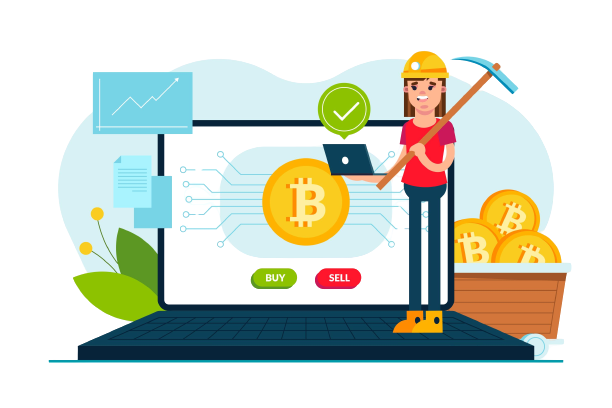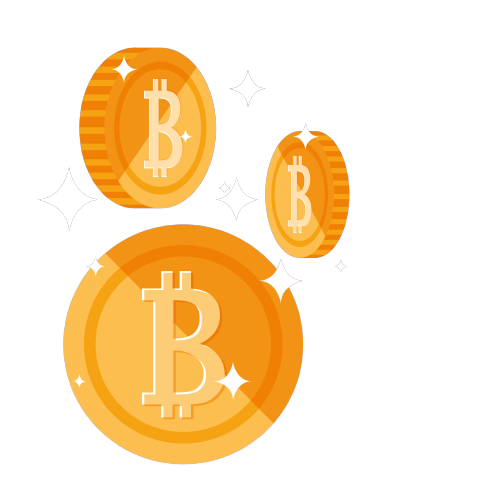
The popularity of cryptocurrency has soared to unprecedented heights, disrupting traditional financial systems and sparking a global conversation about the future of money. Unlike conventional currencies issued and regulated by central banks, cryptocurrencies operate on decentralized networks, using blockchain technology to ensure transparency, security, and efficiency. This decentralized nature has made them particularly appealing to those seeking financial independence, fast transactions, and borderless payments.
As we explore the world of cryptocurrency transactions, we’ll primarily focus on Bitcoin, often referred to as digital gold due to its pioneering status and widespread adoption. Bitcoin’s popularity has paved the way for various Bitcoin wallets, each designed to offer users a seamless and secure experience when buying and sending cryptocurrency.
The Significance of Bitcoin Wallets for Instant Transactions
While cryptocurrencies offer numerous advantages, unlocking their full potential necessitates a fundamental understanding of how to buy and send them efficiently. This is where Bitcoin wallets come into play. A Bitcoin wallet is a software or hardware tool that allows users to store, manage, and interact with their digital assets, primarily Bitcoin.
These wallets are not just digital vaults; they are gateways to the world of cryptocurrency. They enable you to buy Bitcoin from exchanges, receive payments, and, most importantly, send Bitcoin to others, all within seconds. It is this instant transaction capability that makes Bitcoin wallets an integral part of the cryptocurrency ecosystem.
In the following sections of this guide, we’ll explore the intricacies of using Bitcoin wallets to buy and send cryptocurrency with ease. From setting up your wallet to executing transactions securely and efficiently, we’ll provide you with the knowledge and tools you need to navigate this exciting digital frontier.
Let us first begin by understanding what Bitcoin wallets are.
Understanding Bitcoin Wallets
What Is a Bitcoin Wallet?
In the world of cryptocurrency, a Bitcoin wallet is your gateway to the blockchain. It’s a digital tool that allows you to securely store, manage, and interact with your Bitcoin holdings. Imagine it as a digital representation of your traditional wallet, but tailored for the digital currency realm.
At its core, a Bitcoin wallet consists of two key components:
Public Address: This is the part of your wallet that’s visible to the world. It’s akin to your bank account number, and it’s where others send Bitcoin when they want to pay you. Public addresses are safe to share and are used to receive payments.
Private Key: The private key, on the other hand, is your secret key to accessing and managing your Bitcoin. It’s akin to your PIN or password, and it must remain confidential at all times. Anyone with access to your private key can control your Bitcoin holdings, so it’s crucial to keep it secure.
Understanding Bitcoin wallets is essential for anyone entering the world of cryptocurrency. Different types of wallets offer varying degrees of security and accessibility, so it’s crucial to choose the one that aligns with your needs and risk tolerance. Prioritize security measures and choose reputable wallet providers to safeguard your digital assets effectively.
Getting Started
Downloading and Installing a Bitcoin Wallet
The first step on your journey to becoming a cryptocurrency user is to download and install a Bitcoin wallet. This essential tool will serve as your secure vault and user interface for managing your digital assets. Here’s a step-by-step walkthrough to get you started:
Choose Your Wallet: There are various Bitcoin wallets available for different platforms, such as desktop, mobile, and hardware. Research and select a wallet that aligns with your needs and preferences. Popular options include Electrum, Bitamp, Exodus, and Trust Wallet for mobile.
Visit the Official Website: To ensure your wallet is legitimate and secure, always download it from the official website or app store associated with the wallet developer. Avoid downloading wallets from unverified sources to minimize the risk of malware or scams.
Download the Wallet: Click on the download link provided on the official website or in the app store. Make sure you’re downloading the correct version for your operating system (Windows, macOS, iOS, Android, etc.).
Install the Wallet: Follow the installation instructions specific to your operating system. In most cases, this involves running an installer and following on-screen prompts.
Setting Up and Securing Your Wallet
Now that you have your Bitcoin wallet installed, it’s time to set it up and ensure it’s secure. Here are the essential steps:
Create a New Wallet: Upon launching the wallet application, you’ll typically be prompted to create a new wallet. Follow the on-screen instructions to do so.
Strong Password: Choose a strong, unique password for your wallet. A strong password typically includes a combination of upper and lower-case letters, numbers, and special characters. Avoid using easily guessable information like birthdays or common words.
Backup Your Wallet: Most Bitcoin wallets will generate a backup phrase or seed when you create a new wallet. This is a crucial step for securing your wallet. Write down the backup phrase on a piece of paper and store it in a secure location, preferably offline. This phrase is your lifeline to recover your wallet if you forget your password or lose access.
Enable Two-Factor Authentication (2FA): If your wallet supports 2FA, enable it. This adds an extra layer of security by requiring a secondary code to access your wallet.
Explore Wallet Features: Take some time to explore the features and functionality of your wallet. Familiarize yourself with how to receive and send Bitcoin, view your transaction history, and manage your account settings.
Regular Updates: Keep your wallet software up to date by installing the latest updates or patches. Developers often release updates to enhance security and add new features.
Secure Your Device: Ensure the device where your wallet is installed is also secure. Keep your operating system and antivirus software up to date to protect against malware and other security threats.
By following these steps, you’ll have successfully downloaded, installed, and secured your Bitcoin wallet. Your wallet is now ready to be used for receiving, storing, and sending Bitcoin securely and efficiently. Remember to keep your backup phrase safe and never share your password or private key with anyone to maintain the utmost security of your digital assets.
Buying Cryptocurrency Instantly

Buying cryptocurrency, especially Bitcoin, has become more accessible than ever before. In this section, we’ll explore various methods to purchase Bitcoin and other cryptocurrencies instantly and provide step-by-step instructions for each method. The below-mentioned are the most common steps one can follow to buy Bitcoins.
1. Using Cryptocurrency Exchanges:
Cryptocurrency exchanges are online platforms where you can buy, sell, and trade digital currencies. Here’s how to buy Bitcoin using a cryptocurrency exchange:
Step 1: Choose a Cryptocurrency Exchange
Research and select a reputable cryptocurrency exchange. Popular options include Coinbase, Binance, Kraken, and Bitstamp.
Step 2: Create an Account
Sign up for an account on the chosen exchange and complete the necessary identity verification (KYC) procedures, which may include providing identification documents.
Step 3: Deposit Funds
Deposit fiat currency (e.g., USD, EUR) into your exchange account using a bank transfer, credit card, or other supported payment methods.
Step 4: Place an Order
Go to the trading section of the exchange and place a buy order for Bitcoin. You can specify the amount you want to buy and the price at which you want to buy it.
Step 5: Confirm and Store
Once your order is filled, your Bitcoin will be credited to your exchange wallet. For added security, consider transferring your Bitcoin to a private wallet.
2. Peer-to-Peer (P2P) Platforms:
P2P platforms facilitate direct transactions between buyers and sellers. Here’s how to buy Bitcoin using a P2P platform like LocalBitcoins or Paxful:
Step 1: Choose a P2P Platform
Sign up for an account on a reputable P2P platform.
Step 2: Search for Sellers
Browse listings from sellers offering Bitcoins and review seller profiles and feedback ratings.
Step 3: Initiate a Trade
Select a seller and initiate a trade and follow the instructions provided by the seller, which may include making a payment through a supported method like bank transfer or cash deposit.
Step 4: Complete the Transaction
Confirm the payment with the seller. Once the seller verifies the payment, they will release the Bitcoin to your P2P wallet.
3. Bitcoin ATMs:
Bitcoin ATMs are physical machines that allow you to buy Bitcoin with cash or credit/debit cards. Here’s how to use a Bitcoin ATM:
Step 1: Find a Bitcoin ATM
Use a Bitcoin ATM map or directory to locate a nearby machine.
Step 2: Verify Your Identity (if required)
Some ATMs may require identity verification, so be prepared to provide identification if prompted.
Step 3: Purchase Bitcoin
Follow the on-screen prompts to select the amount of Bitcoin you want to purchase.
Insert cash or use a credit/debit card for payment.
Step 4: Receive Bitcoin
Once the transaction is complete, the Bitcoin will be sent to your wallet address. Ensure you have a wallet ready to receive the funds.
4. Mobile Apps:
Several mobile apps, such as Coinbase, Binance, and Cash App, allow you to buy Bitcoin directly from your smartphone. Here’s how to do it:
Step 1: Download a Cryptocurrency App
Download and install a reputable cryptocurrency app from your app store.
Step 2: Sign Up
Create an account or sign in if you already have one.
Step 3: Add Payment Method
Link your bank account, credit card, or payment method to the app.
Step 4: Buy Bitcoin
Navigate to the Buy/Sell section within the app. Enter the amount of Bitcoin you want to purchase and confirm the transaction.
Step 5: Store Your Bitcoin
The purchased Bitcoin will be stored in your app wallet. For added security, consider transferring it to a private wallet.
Each of these methods offers a convenient way to buy Bitcoin and other cryptocurrencies instantly. However, it’s essential to research and choose a method that aligns with your preferences and to prioritize security when handling your digital assets.
Storing Cryptocurrency

Receiving and storing cryptocurrency in your wallet involves obtaining a unique wallet address and sharing it with the sender or source of the cryptocurrency. Wallet addresses are critical for ensuring the secure and accurate transfer of digital assets. QR codes simplify this process and enhance the efficiency and accuracy of cryptocurrency transactions. Properly managing wallet addresses and using QR codes ensures that your digital assets are securely stored and accessible when needed.
Sending Cryptocurrency Instantly
Sending cryptocurrency from your wallet to another wallet address is a straightforward yet crucial process in the world of digital assets. Sending cryptocurrency from your wallet involves entering the recipient’s wallet address, specifying the amount, and handling transaction fees. Accuracy and security are paramount during this process, as cryptocurrency transactions are irreversible. Following the correct steps and best practices will help you send cryptocurrency quickly and securely to your intended recipient.
Transaction Confirmations
Blockchain confirmations are vital for securing cryptocurrency transactions. The number of confirmations required depends on the level of security needed, and the time for confirmations to occur can vary based on network conditions. To facilitate faster transactions, consider adjusting transaction fees, using SegWit addresses for Bitcoin, and staying informed about network congestion. These tips can help you navigate the dynamic world of cryptocurrency transactions effectively.
Troubleshooting Common Issues
Cryptocurrency transactions, while generally reliable, can sometimes run into issues. Remember that cryptocurrency transactions are irreversible, so it’s essential to take precautions to avoid common issues like stuck transactions, sending funds to incorrect addresses, or wallet synchronization problems. Diligence and understanding of the blockchain network can help you navigate these challenges and ensure the security of your digital assets.
Resolving The Issues:
Check Network Connection: Ensure that your device has a stable internet connection. Synchronization requires regular communication with the blockchain network.
Update Wallet Software: Keep your wallet software up to date. Developers often release updates to improve synchronization performance and resolve bugs.
Blockchain Rescan: Some wallets provide an option to rescan the blockchain. This can help resolve synchronization issues by rechecking all transactions on the blockchain.
Rebuild the Wallet: In some cases, you may need to rebuild or restore your wallet from a backup. Make sure you have a secure backup of your wallet’s seed phrase or private keys before attempting this.
Support and Forums: If you continue to experience synchronization issues, reach out to the wallet’s support team or check online forums and communities for user-contributed solutions.
Towards The End
In conclusion, the ability to buy and send cryptocurrency instantly is a powerful feature of the digital currency revolution. With the right knowledge and tools, anyone can participate in the world of cryptocurrencies, utilizing Bitcoin wallets, cryptocurrency exchanges, peer-to-peer platforms, Bitcoin ATMs, and mobile apps to facilitate quick and secure transactions. However, it’s crucial to approach these processes with a strong emphasis on security, selecting reputable services, and adhering to best practices to safeguard your digital assets. Whether you’re a newcomer exploring the exciting possibilities of cryptocurrency or an experienced user seeking efficiency and convenience, mastering the art of buying and sending crypto instantly empowers you to be part of this transformative financial landscape.